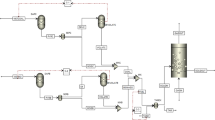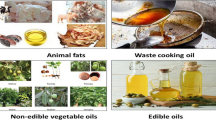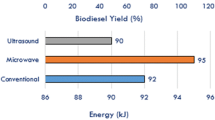Abstract
In order to investigate the effects of methyl ester moiety on polycyclic aromatic hydrocarbons (PAHs) and NO x formation in biodiesel combustion, the combined models were developed based on detailed methyl butanoate (MB) oxidation model and n-butane model. Also, PAHs detailed reaction mechanism and NO x formation mechanism were added to the detailed models to form the combined models. The combined models were used to compare the combustion of n-butane and MB in a shock tube simulation to understand the effects of methyl ester moiety. The results indicated that compared with n-butane, the methyl ester moiety in MB leads to different reaction pathways, more CO and CO2 formation and less formation of PAHs precursors such as ethylene and acetylene. In addition, a better chemical insight into the effects of methyl ester moiety on NO x formation was given, which will help to understand the combustion process of biodiesel.
Similar content being viewed by others

References
Im S Y, Song Y S, Ryu J I. Experimental study of the physical and chemical characteristics of biodiesel blended fuel using ultrasonic energy irradiation[J]. Int J Auto Tech, 2008, 9(3): 249–256.
Zhang X, Gao G, Li L et al. Characteristics of combustion and emissions in a DI engine fueled with biodiesel blends from soybean oil [C]. In: SAE Paper. 2008, 2008-01-1832.
Lee C S, Park S W, Kwon S I. An experimental study on the atomization and combustion characteristics of biodiesel-blended fuels[J]. Energy Fuel, 2005, 19(5): 2201–2209.
Szybist J P, Song J, Alam M et al. Biodiesel combustion, emissions and emission control[J]. Fuel Process Technology, 2007, 88(7): 679–691.
Fisher E M, Pitz W J, Curran H J et al. Detailed chemical kinetic mechanisms for combustion of oxygenated fuels[ J]. Symp Int Combust, 2000, 28(2): 1579–1586.
Curran H J, Gaffuri P, Pitz W J et al. A comprehensive modeling study of n-heptane oxidation[J]. Combustion and Flame, 1998, 114(1/2): 149–177.
Metcalfe W K, Dooley S, Curran H J et al. Experimental and modeling study of C5H10O2 ethyl and methyl esters[J]. J Phys Chem A, 2007, 111(19): 4001–4014.
Dooley S, Curran H J, Simmie J M. Autoignition measurements and a validated kinetic model for the biodiesel surrogate, methyl butanoate[J]. Combustion and Flame, 2008, 153(1/2): 2–32.
Lin Kuang C, Lai Jason Y W, Violi Angela. The role of the methyl ester moiety in biodiesel combustion: A kinetic modeling comparison of methyl butanoate and n-butane [J]. Fuel, 2012, 92(1): 16–26.
Sarathy S M, Gaeil S, Syed S A et al. A comparison of saturated and unsaturated C4 fatty acid methyl esters in an opposed flow diffusion flame and a jet stirred reactor[J]. Proceedings of the Combustion Institute, 2007, 31(1): 1015–1022.
Gail S, Sarathy S M, Thomson M J et al. Experimental and chemical kinetic modeling study of small methyl esters oxidation: Methyl (e)-2-butenoate and methyl butanoate[ J]. Combustion and Flame, 2008, 155(4): 635–650.
Westbrook C K, Pitz W J, Curran H J. Chemical kinetic modeling study of the effects of oxygenated hydrocarbons on soot emissions from diesel engines[J]. J Phys Chem A, 2006, 110(21): 6912–6934.
Appel J, Bockhorn H, Frenklach M. Kinetic modeling of soot formation with detailed chemistry and physics: Laminar premixed flames of C2 hydrocarbons[J]. Combustion and Flame, 2000, 121(1/2): 122–136.
Amneus P, Mauss F, Kraft M et al. NOx and N2O formation in HCCI engines[C]. In: SAE Paper. 2005, 2005-01-0126.
Vaughn T, Hammill M, Harris M et al. Ignition delay of bio-ester fuel droplets[C]. In: SAE Paper. 2006, 2006-01-3302.
Hadjali K, Crochet M, Vanhove G et al. A study of the low temperature autoignition of methyl esters[J]. Proceedings of the Combustion Institute, 2009, 32(1): 239–246.
Herbinet O, Pitz W J, Westbrook C K. Detailed chemical kinetic oxidation mechanism for a biodiesel surrogate[J]. Combustion and Flame, 2008, 154(3): 507–528.
Westbrook C K, Dryer F L. Simplified reaction mechanisms for the oxidation of hydrocarbon fuels in flames[J]. Combust Sci Tech, 1981, 27(1/2): 31–43.
Clifford L J, Milne A M, Murray B A. Numerical modeling of chemistry and gas dynamics during shock-induced ethylene combustion[J]. Combustion and Flame, 1996, 104(3): 311–327.
Donato N S, Petersen E L. Simplified correlation models for CO/H2 chemical reaction times[J]. Int J Hydrogen Energy, 2008, 33(24): 7565–7579.
Kee R J, Rupley F M, Miller J A et al. CHEMKIN Release 4. 1[M]. Reaction Design, San Diego, 2006.
Horning D C, Davidson D F, Hanson R K. Study of the high-temperature autoignition of n-alkane/O/Ar mixtures[ J]. Journal of Propulsion and Power, 2002, 18(2): 363–371.
Lapuerta M, Armas O, Rodriguez-Fernandez J. Effect of biodiesel fuels on diesel engine emissions[J]. Progress in Energy and Combustion Science, 2008, 34(2): 198–223.
Mueller C J, Boehman A L, Martin G C. An experimental investigation of the origin of increased NOx emissions when fueling a heavy-duty compression-ignition engine with soy biodiesel[C]. In: SAE Paper. 2009, 2009-01-1792.
Hess M, Haas M, Foglia T et al. Effect of antioxidant addition on NOx emissions from biodiesel[J]. Energy & Fuels, 2005, 19(4): 1749–1754.
Fenimore C P. Formation of nitric oxide in premixed hydrocarbon flames[J]. Proceedings of the Combustion Institute, 1971, 13: 373–380.
Liberman M A. Introduction to Physics and Chemistry of Combustion: Explosion, Flame, Detonation[M]. Springer, Berlin, 2008.
Szybist J P, Boehman A L, Taylor J D et al. Evaluation of formulation strategies to eliminate the biodiesel NOx effect[ J]. Fuel Process Technology, 2005, 86(10): 1109–1126.
Guo H, Smallwood G J, Gülder Ö L. The effect of reformate gas enrichment on extinction limits and NOx formation in counterflow CH4/air premixed flames[J]. Proceedings of the Combustion Institute, 2007, 31: 1197–1204.
Author information
Authors and Affiliations
Corresponding author
Additional information
Supported by National Natural Science Foundation of China (No. 50776077).
Shu Gequn, born in 1964, male, Dr, Prof.
Rights and permissions
About this article
Cite this article
Shu, G., Xu, B., Zhang, W. et al. Chemical kinetic modeling for the effects of methyl ester moiety in biodiesel on PAHs and NO x formation. Trans. Tianjin Univ. 19, 168–173 (2013). https://doi.org/10.1007/s12209-013-1936-5
Accepted:
Published:
Issue Date:
DOI: https://doi.org/10.1007/s12209-013-1936-5



